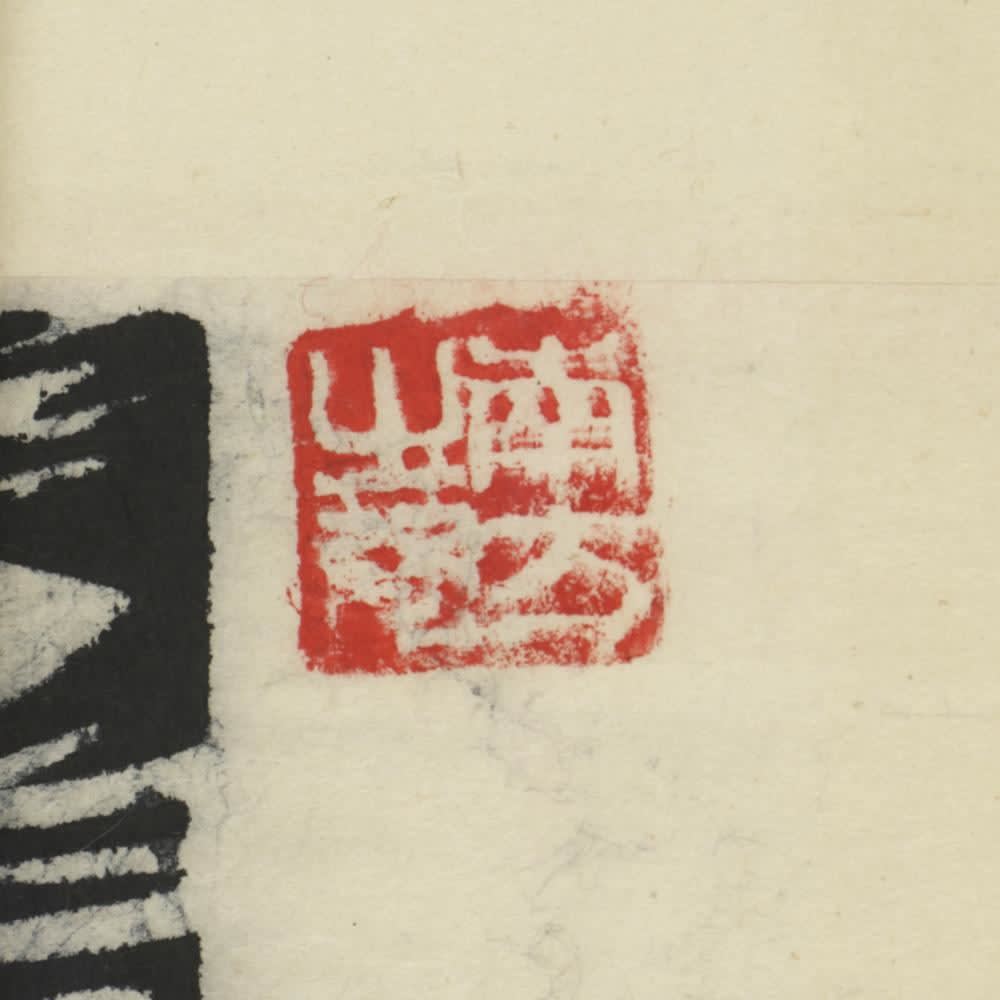Munakata Shikō (1903−1975)
Green Plain
Woodblock print on paper, framed
1965
With a Munakata Shiko kantei iinkai certificate
Seals: Nampo no kyo, Hogen Muna Shiko
88.5 x 114.8 cm
104 x 131 cm (overall)
Further images
In 1956, a woodblock work titled Sogen (later, renamed to Sogen no saku) was submitted to the twelfth Nitten Exhibition. In the lower left of the present work, Munakata Shiko penciled “1965.9.15 printed,” confirming this was reprinted in 1965. As a work made with a single woodblock, this could be regarded as the largest size in terms of dimension. The entire painting assembles four large, oblong papers together, which is a technique often used by the artist for making such large-scale works.
Four lively, naked women stand majestically in a row against one another. The images, connecting to the black-figure pottery painting on the ancient Greek vase, or to the relief in the ancient sculpture, are endowed with the power of the earth. The vine-like decorations gracefully climb across the women’s necks, the waists, and the bodies engender them sacredness. Varied relief patterns deftly engraved on the woodblock are emerged from the back of the paper, symbolizing that they are the fertile grass, the flowing water, and the strewn petals. On top of that, the subtle light-dark tonality of ink brushed from the back side of the paper lends vigor to these women.
Although when it comes to Munakata Shiko, the works with rich hand-applied colors would be first mentioned, the primitiveness of life that he keeps seeking out through the world of woodblock print could be clearly seen in such monochromatic works.
Munakata Shiko (woodblock print artist; 1903−1975)
Aomori-born woodblock print artist. First taught himself Western-style painting, and was admitted to exhibit at Teiten (Imperial Academy of Fine Arts Exhibition). Aspired to become a woodblock print artist under the influence of the print artists Furukawa Ryusei and Kawakami Sumio. Acquaintance with the founding members of the Mingei movement Yanagi Muneyoshi, Kawai Kanjiro and Hamada Shoji had brought transformation in his artmaking. Later produced a great many masterpieces on religious subjects. Built up a unique form of woodblock print that brings writings into the picture, combining and harmonizing the visual effects of the two elements. Designated as a Person of Cultural Merit and received the Order of Culture.
Four lively, naked women stand majestically in a row against one another. The images, connecting to the black-figure pottery painting on the ancient Greek vase, or to the relief in the ancient sculpture, are endowed with the power of the earth. The vine-like decorations gracefully climb across the women’s necks, the waists, and the bodies engender them sacredness. Varied relief patterns deftly engraved on the woodblock are emerged from the back of the paper, symbolizing that they are the fertile grass, the flowing water, and the strewn petals. On top of that, the subtle light-dark tonality of ink brushed from the back side of the paper lends vigor to these women.
Although when it comes to Munakata Shiko, the works with rich hand-applied colors would be first mentioned, the primitiveness of life that he keeps seeking out through the world of woodblock print could be clearly seen in such monochromatic works.
Munakata Shiko (woodblock print artist; 1903−1975)
Aomori-born woodblock print artist. First taught himself Western-style painting, and was admitted to exhibit at Teiten (Imperial Academy of Fine Arts Exhibition). Aspired to become a woodblock print artist under the influence of the print artists Furukawa Ryusei and Kawakami Sumio. Acquaintance with the founding members of the Mingei movement Yanagi Muneyoshi, Kawai Kanjiro and Hamada Shoji had brought transformation in his artmaking. Later produced a great many masterpieces on religious subjects. Built up a unique form of woodblock print that brings writings into the picture, combining and harmonizing the visual effects of the two elements. Designated as a Person of Cultural Merit and received the Order of Culture.







